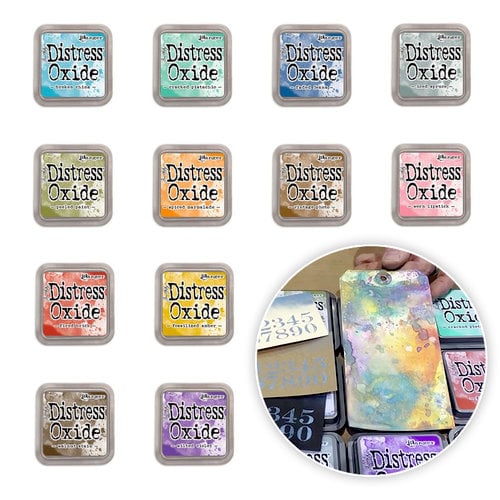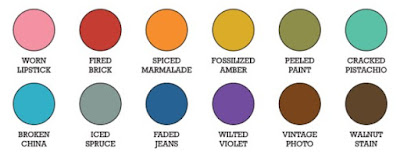The 12 new colors are :
Tim Holtz Distress Oxide Inks are manufactured by Ranger Industries in New Jersey in the United States.
In a press release e-mail sent just a few hours ago Ranger said, " Introducing 12 new colors of Tim Holtz Distress® Oxide Ink Pads, a water-reactive dye & pigment ink fusion that creates an oxidized effect when sprayed with water. Use with stamps, stencils and direct to surface. Blend using Ink Blending Tools and Foam. All oxide colors are available in 3" x 3" ink pads and coordinating .5 oz re-inkers.".
The first 12 colors of Distress Oxide Inks were released earlier this year at Creativation. Creativation ,formerly known as the CHA Mega Show, is the creative industries largest trade show that happens once a year in January. Since Creativation was moved to Phoenix last year I had the opportunity to finally attend. I saw these inks in person and knew they would be a hit. Retailers have been having a hard time keeping them on their shelves.
The 12 colors that were released in January:
This is a nice start for a palette of colors. The Distress Ink palette consists of 61 colors (including white) so we can only speculate that eventually we will get all of the Distress Ink colors in Distress Oxide Ink form.
Distress Inks and Distress Oxide Inks come in a 3 x 3" ink pad and retail for $5.99 each. Distress Inks are also offered in a mini cube form. We can only hope that Distress Oxides will eventually be released in this space saving option. Currently the white Distress Ink is not offered in the mini cube form. This can lead to speculation that maybe a formula such as distress oxide inks does not keep well on a smaller ink pad. I won't be holding my breathe that the Distress Oxides may be released in a smaller 1 x 1 " size.
3 x 3 " cube:
1 x 1 " Mini Cube:
Want to get your hands on some Distress Oxide Inks? Here's some links!

Ranger Ink - Tim Holtz - Distress Oxides Ink Pad Kit - Complete 2017 Bundle - $61.19
Retail Price: $72.00
You Save: $10.81
from: Scrapbook.com

Tim Holtz Distress OXIDE INK PAD SET OF 12 Ranger RANGER97 - $71.99
from: Simon Says Stamp
What is your favorite current Distress Oxide Color? I just find all of the blues so dreamy but I think I would have to pick Cracked Pistachio. I can't wait for them to bring out Mermaid Lagoon!
* Affiliate Links are used at no cost to you. They get me a small commission if you do purchase something using this link. It does not cost you anything. It is your way of saying "thanks for the suggestion". It helps support my hobby and will help me to bring more content to the blog and my youtube channel, IntoxicatingArts. Thank you!





